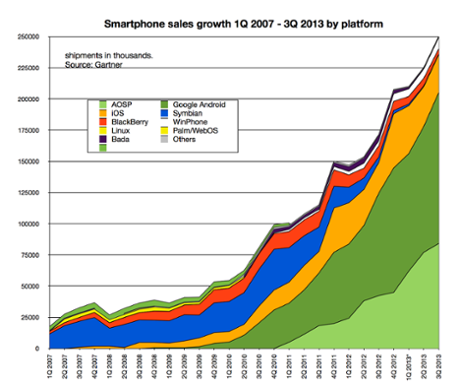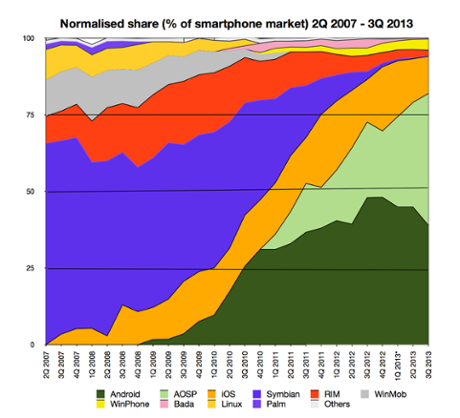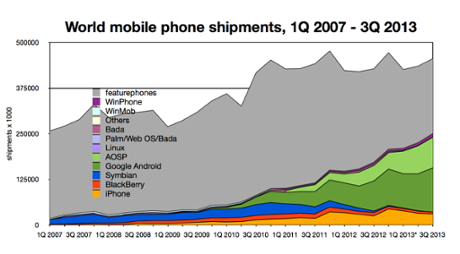| samsung galaxy s3 |
| iphone |
| iphone 6 |
| iphone 5 price |
| iphone g4 |
| how much is iPhone |
| how much is a iPhone |
| the iPhone 5 |
| 64gb iphone |
| iPhone providers |

The number of smartphone owners keeps increasing - and many are in China, buying low-end "Android" phones which don't run Google services, according to new data published by the research companies Gartner and IDC.
Gartner has for the first time lifted the lid on the gigantic growth in sales of Android phones which don't run Google services in China - so-called "AOSP" (Android Open Source Platform) handsets, which use local app stores and do not count towards "activations" measured by Google, nor hook into Google services.
The figures, released on Thursday, show a two-speed smartphone market, with AOSP sales in China nearly doubling in a year - increasing to 84.1m in the third quarter of 2013 from 42.3m a year ago - while growth outside it was only 28% year-on-year.
But China, where AOSP handsets with prices ranging from $150 to $300 make about 90% of handset sales, is now such a large share of the world market that it drove overall smartphone growth to 77.3%.

AOSP handsets made up 41% of all "Android" phones shipped in the third quarter, according to Gartner, up from 34% a year ago. They connect to dozens of app stores, or are sold through companies such as Xiaomi or Tencent.
China is the world's largest smartphone consumer, with sales there reaching roughly 85m in the third quarter, and 1.1 billion people having mobile phones. Chinese consumers are also eager purchases of phones, with a Umeng Analytics study recently finding that 90% replaced their phone at least once every 15 months.
Even discounting China's giant presence, "Google Android" phones made up 100.9m, or 72%, of phones shipped during the third quarter, cementing Google's grip on the sector.


But in the US, which is still the world's richest smartphone market, other data from industry analyst Chetan Sharma suggested that during the quarter Android handsets only made up 54% of shipments in the US market, against 42% for Apple. Smartphones made up nearly 90% of handsets sold during the quarter, Sharma said; 64% of owners there now have smartphones, but that is concentrated among 40% of households - "leaving plenty of growth in the marketplace."
Sharma added: "Though China has overtaken (primarily because of the sheer size of its population) US in terms of the overall smartphone penetration, US remains the market where OEMs have to be really successful in order to be consider a serious player on the larger canvas. Though the likes of Xiaomi and Micromax [which is popular in India] have had good success in their local markets (and still have a great amount of growth left), the prized market to make a sizable dent in their overall revenue and margins is the US market."
Price drop
Separately, IDC's figures showed that the world average selling price (ASP) of a smartphone dropped by 12.5% year-on-year in the third quarter to $317 - indicative of more phones being sold at lower prices.
The average is pulled down by the cheaper handsets in China. “Sales of feature phones continued to decline and the decrease was more pronounced in markets where the ASP for feature phones was much closer to the ASP of affordable smartphones,” said Anshul Gupta, principal research analyst at Gartner. “In markets such as China and Latin America, demand for feature phones fell significantly as users rushed to replace their old models with smartphones.”
However larger-screened "phablets" measuring over 5in diagonally kept a higher price, at $443 - although they had fallen even further, by 22.8% from last year's $573.
The dropping ASP for smartphones caused by low-end market expansion, particularly in China, is putting added pressure on mid-range vendors, while leaving open the question of how long Apple can maintain its premium pricing on the iPhone - which had an ASP of $577 in the third quarter, according to the company's results.
Samsung accounted for just under 40% of all Android shipments, including China, according to IDC. But it is the only non-Chinese vendor in the top ten Android sellers there; Lenovo and Yulong dominate, with Xiaomi - which recently hired Google executive Hugo Barra - holding 4.3% of the market there.
Lenovo became the seventh largest smartphone vendor - although more than 95% of its phones were sold inside China.
Android vendors: pressure below the top
IDC highlighted concerns about the financial pressures on Android handset makers, where Samsung is the only one known to make significant profits. "The vast majority of its vendors still struggle to find meaningful market share," IDC noted, pointing out that besides Samsung, "the rest of the vendors either saw single-digit market share or, in the case of the majority of vendors, market share of less than 1%." HTC, the Taiwanese company which was once the largest Android supplier in the US, recently announced its first quarterly loss, and is expected to break even during the current period by selling its shares in the Beats headphone company for $265m.
In some cases Android vendors are seeking diversification."Almost all successful Android vendors have added one or more 5-7-inch phablets to their product portfolios," said Ryan Reith, IDC's program director. "And Nokia’s recent announcement of the Lumia 1320 and 1520 put them in the category as well." Reith says that in the third quarter phablet shipments accounted for 21% of the smartphone market, up from just 3% a year ago - that is, 54.8m devices, compared to 5.6m a year ago.
"We believe the absence of a large-screen device may have contributed to Apple's inability to grow share in the third quarter," Reith added. Apple is rumoured to be working on a larger-screened phone for release in 2014, though the company has not commented on the reports.
Apple squeezed
While Apple increased the number of handsets it shipped to 30.3m, up 23.1% year-on-year, its share of worldwide sales including China fell to 12.1%, its lowest since the start of 2009. Excepting China, it was about 18%; the company does not disclose shipments of iPhones inside China.
Both Gartner and IDC expressed doubts about Apple's pricing of its colourful iPhone 5C product, which was launched at the same time as the high-end fingerprint-reading iPhone 5S.
With carriers complaining that there is little difference in the wholesale price of the 5S and 5C, many are preferring to focus sales on the 5S, which has a higher selling price to customers. Gartner commented that "the price difference between the iPhone 5c and 5s is not enough in mature markets, where prices are skewed by operator subsidies, to drive users away from the top of the line model. In emerging markets, the iPhone 4S will continue to be the volume driver at the low end as the lack of subsidy in most markets leaves the iPhone 5c too highly priced to help drive further penetration."
Nokia grows
Windows Phone saw success, particularly in low-end markets, as Nokia began to win buyers. Sales of handsets running Microsoft's software more than doubled, from 4m a year ago to 8.9m in the third quarter, Gartner said. Nokia's handset business - which Microsoft is preparing to take over early in 2014 - remains the largest vendor of the software. Gartner noted that "regional and Chinese Android device manufacturers continued to beat market demand, taking larger share and creating a tough competitive environment for Lumia devices." Even excluding China, the figure still leaves Windows Phone with only 5% of shipments three years after its launch.
No comments:
Post a Comment